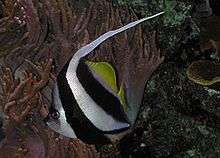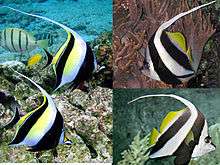Schooling bannerfish
The schooling bannerfish (Heniochus diphreutes), also known as the false moorish idol, is a butterflyfish native to the Indo-Pacific area.
| Schooling fish | |
|---|---|
 | |
| Scientific classification | |
| Kingdom: | Animalia |
| Phylum: | Chordata |
| Class: | Actinopterygii |
| Order: | Perciformes |
| Family: | Chaetodontidae |
| Genus: | Heniochus |
| Species: | H. diphreutes |
| Binomial name | |
| Heniochus diphreutes D. S. Jordan, 1903 | |
Description
The schooling bannerfish is a small fish that can reach a maximum length of 18–21 cm.[2][3]
Its body is compressed laterally, and the first rays of its dorsal fin stretch in a long white filament. Its background color is white with two large black diagonal bands. Beyond the second black stripe, the dorsal, caudal fins and pectoral fins are yellow. The head is white, the eyes are black and linked together by a black to gray band. The short snout, spotted with black to gray, has a small terminal, extensible mouth.

Distribution and habitat
The schooling bannerfish is widespread throughout the tropical, subtropical and temperate waters of the Indo-Pacific from the eastern coast of Africa, Red Sea included, to Polynesia and Hawaii and from south Japan to Kermadec Islands (New Zealand).[1][2]
The schooling bannerfish prefers external reef slopes and channels. It has a large depth range and is usually observed at 5–30 m depth, but may reach 210 meters deep in some localities.[2][4]
Ecology
As is indicated by its common name, the schooling bannerfish lives in large groups. It feeds on zooplankton in the open water, and juveniles may act as cleaner fish.[2][3][5]
Conservation status
In some geographic areas, the schooling bannerfish is harvested for the aquarium trade and is commonly sold as a cheaper alternative to the Moorish idol. However, there do not appear to be any major current threats to this species, and it is listed as Least Concern by the IUCN.[1]
References
- Rocha, L.A., Pyle, R., Myers, R., Craig, M.T., Pratchett, M. & Carpenter, K.E. (2010). "Heniochus diphreutes". IUCN Red List of Threatened Species. 2010: e.T165683A6090332. doi:10.2305/IUCN.UK.2010-4.RLTS.T165683A6090332.en.CS1 maint: uses authors parameter (link)
- Lieske & Myers,Coral reef fishes,Princeton University Press, 2009, ISBN 9780691089959
- Kuiter, R.H. and T. Tonozuka, 2001. Pictorial guide to Indonesian reef fishes. Part 2. Fusiliers - Dragonets, Caesionidae - Callionymidae. Zoonetics, Australia. 304-622 p.
- Allen, G.R. and M.V. Erdmann, 2012. Reef fishes of the East Indies. Perth, Australia: Universitiy of Hawai'i Press, Volumes I-III. Tropical Reef Research.
- Rudie Kuiter, “Chaetodontidae & Microcanthidae”, Aquatic Photographics, 2004, ISBN 0953909735
External links
- Photos of Schooling bannerfish on Sealife Collection
| Wikimedia Commons has media related to Heniochus diphreutes. |
